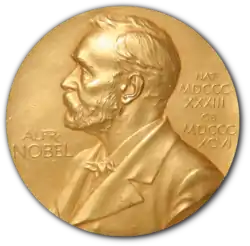Robert Coleman Richardson
Robert Coleman Richardson (June 26, 1937 – February 19, 2013)[1] was an American experimental physicist whose area of research included sub-millikelvin temperature studies of helium-3. Richardson, along with David Lee, as senior researchers, and then graduate student Douglas Osheroff, shared the 1996 Nobel Prize in Physics for their 1972 discovery of the property of superfluidity in helium-3 atoms in the Cornell University Laboratory of Atomic and Solid State Physics.[2][3][4]
Robert Coleman Richardson | |
|---|---|
 | |
| Born | June 26, 1937 Washington, D.C., U.S. |
| Died | February 19, 2013 (aged 75) |
| Nationality | United States |
| Alma mater | Virginia Tech (B.S., M.S.) Duke University (Ph.D.) |
| Known for | Discovering superfluidity in helium-3 |
| Awards | Oliver E. Buckley Condensed Matter Prize (1981) Nobel Prize in Physics (1996) |
| Scientific career | |
| Fields | Physics |
| Institutions | Cornell University |
| Doctoral advisor | Horst Meyer |
Richardson was born in Washington D.C. He went to high school at Washington-Lee in Arlington, Virginia. He later described Washington-Lee's biology and physics courses as "very old-fashioned" for the time. "The idea of 'advanced placement' had not yet been invented," he wrote in his Nobel Prize autobiography. He took his first calculus course when he was a sophomore in college.[5]
Richardson attended Virginia Tech and received a B.S. in 1958 and a M.S. in 1960. He received his PhD from Duke University in 1965.
Background
At the time of his death, he was the Floyd Newman Professor of Physics at Cornell University, although he no longer operated a laboratory. From 1998 to 2007 he served as Cornell's vice provost for research, and from 2007 to 2009 was senior science adviser to the president and provost. His past experimental work focused on using Nuclear Magnetic Resonance to study the quantum properties of liquids and solids at extremely low temperatures.
Richardson was an Eagle Scout, and mentioned the Scouting activities of his youth in the biography he submitted to the Nobel Foundation at the time of his award.[1]
Richardson claimed that he did not believe in an anthropomorphic God, but it is unclear what specific beliefs he held.[6]
Awards and Honors
- Oliver E. Buckley Condensed Matter Prize (1981)
- Nobel Prize in Physics (1996)
- Golden Plate Award of the American Academy of Achievement (1997)[7]
References
- "Biography". Nobel Foundation.
- Osheroff, DD; RC Richardson; DM Lee (1972). "Evidence for a New Phase of Solid He3". Physical Review Letters. 28 (14): 885–888. Bibcode:1972PhRvL..28..885O. doi:10.1103/PhysRevLett.28.885.
- Osheroff, DD; WJ Gully; RC Richardson; DM Lee (1972). "New Magnetic Phenomena in Liquid He3 below 3mK". Physical Review Letters. 29 (14): 920–923. Bibcode:1972PhRvL..29..920O. doi:10.1103/PhysRevLett.29.920.
- "The Nobel Prize in Physics 1996". The Nobel Prize in Physics. Nobel Foundation. 2007. Retrieved 2007-08-05.
- Chang, Kenneth (2013-02-22). "Robert C. Richardson, 75, Laureate in Physics, Dies". The New York Times. p. B14.
- Jonathan Pararajasingham, ed. (2011). "50 Renowned Academics Speaking About God". Retrieved 2016-09-04.
But, I do not believe in an anthropomorphic god...
- "Golden Plate Awardees of the American Academy of Achievement". www.achievement.org. American Academy of Achievement.
External links
- Cornell webpage
- Freeview video Interview with Robert Richardson by the Vega Science Trust
- Obituaries
- Cornell obituary
- "Robert Richardson". The Telegraph. 21 Feb 2013.
- Kenneth Chang (21 February 2013). "Robert C. Richardson, Laureate in Physics, Dies at 75". The New York Times.
- Hamish Johnston (21 February 2013). "Robert Richardson: 1937–2013". physicsworld.com.
- Robert C. Richardson on Nobelprize.org
 including the Nobel Lecture, December 7, 1996 The Pomeranchuk Effect
including the Nobel Lecture, December 7, 1996 The Pomeranchuk Effect
